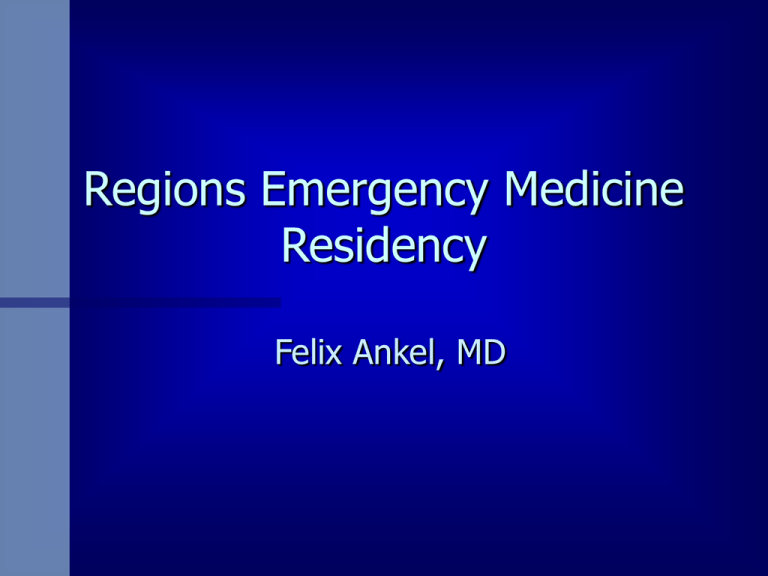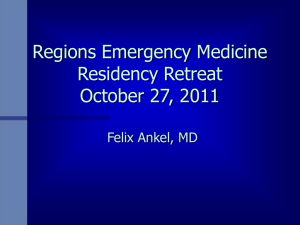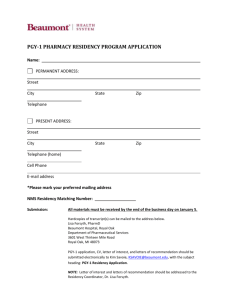2010 Residency Retreat Slides - the Regions Hospital Emergency
advertisement

Regions Emergency Medicine Residency Felix Ankel, MD History Accreditation 1995, 1999, 2003, 2009 99 graduates 1999-present 128 residents 1996-present Mission:PAPEEMCE Provide and promote excellence in emergency medicine care and education Patient centered Resident focused Team oriented Transparency Professionalism Knowledge Skills Attitudes Core competencies Contribution to specialty 99 graduates 1999-present 67 Minnesota: 15 Regions, 11 EPPA, 7 Fairview-U, 6 North, 5 Abbott, 5 HealthEast, 5 United, 4 Duluth, 2 Waconia, Shakopee, Brainerd, Rochester, New Ulm, Princeton 31 out of state: SD 5, NE 3, IA 4, ND 3, CO 2, IN 2, WI 2, MT 2, WA 2, CA, NH, NY, OR, UT, VA 17 Academic: 15 Regions, Wishard, Mayo 14 Hybrid: 7 Fairview-U, 6 North, Mercy-Iowa City 67 Community 9 Fellows (3 toxicology, faculty development, critical care, simulation, informatics, ultrasound, EMS) 128 residents (1996 - present) 38 medical schools 45 U of M 8 UND 7 MCW, Iowa, USD, Mayo 5 Creighton 4 UW 2 Nebraska, Loyola, Indiana, Kansas, Chicago Med School, Colorado, Loma Linda, SLU SUNY-Buffalo, Des Moines, Nevada, Vermont, Penn, Hawaii, East Carolina, Arizona, Utah, Michigan State, SUNY-Syracuse, VA-COM, UCSF, Dartmouth, Yale, Tufts, Cincinnati, Morehouse, Florida, Nova-COM, Temple, LSU 30 Faculty (13 Different EM Residencies) Regions x 15 Henry Ford x 2 Harvard Affiliated x 2 Illinois x 2 HCMC Brooke Army St Vincent’s Christ Indiana Boston Medical Center Grand Rapids Michigan Resurrection Residency Strategic Plan 2005-2010 4/28/05 SWOT analysis Conferences Simulation Mentorship Administrative curriculum Scholarly activity Individualization of educational experience Integration with U of M Integration with twin city hospitals National presence 2009-2010 ED-I rotation (EM, Anes, EMS) 3 new ultrasound machines EM-3 Peds anesthesia New ED Cards/Hospitalist rotation Fellowship development (EM-Peds, EMS, International) Residency Strategic Plan 2010-2015 4/21/010 SWOT analysis Review of strategic plans of department, hospital, IME, and healthplan Outcomes (quality) Knowledge translation (web 2.0 and work with librarians) Procedural competency Non-clinical training (longitudinal admin) Benchmarks and scorecards Resources (wellness and resilience) Program review 2010 Residency coordination Cardiology rotation Resident support Ortho rotation Social work staff Admin rotation Faculty supervision Anesthesia rotation Progressive responsibility Education vs service Residency leadership Research EMS Plastics rotation 2010-2011 10 interns New procedural skills lab EMS fellow, EM-peds sponsorship Quality, international fellowship approval ROD, MSOD – longitudinal admin experience Night float block Hudson selective pilot Quality teams Recruitment boom Thoughts Caring for patients vs. treating patients Complex vs. complicated system Wisdom of Crowds, James Surowiecki The Culture Code, Clotaire Rapaille The Foucault Reader, Paul Rabinow (Ed.) Drive, Dan Pink Questions to consider Web 2.0 – Consolidate and optimize current on line interactive resources Longitudinal admin experience – Determine strengths and areas to tweak QI program design – Review, discuss progress and recommend improvement Wellness and resilience – Develop plan to maintain and improve current wellness and resilience Questions to consider






